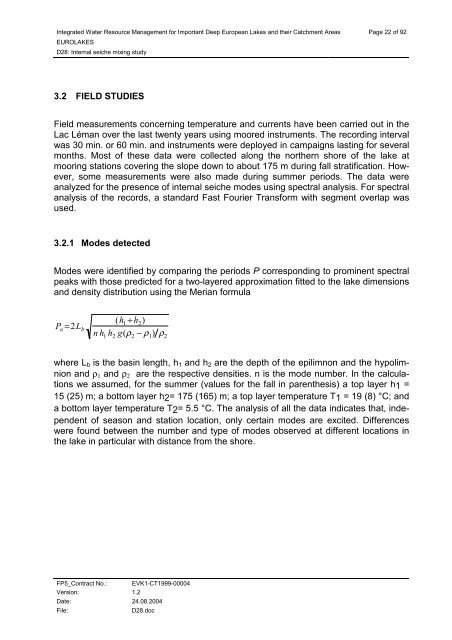D28: Internal seiche mixing study - Hydromod
D28: Internal seiche mixing study - Hydromod
D28: Internal seiche mixing study - Hydromod
Create successful ePaper yourself
Turn your PDF publications into a flip-book with our unique Google optimized e-Paper software.
Integrated Water Resource Management for Important Deep European Lakes and their Catchment Areas<br />
EUROLAKES<br />
<strong>D28</strong>: <strong>Internal</strong> <strong>seiche</strong> <strong>mixing</strong> <strong>study</strong><br />
3.2 FIELD STUDIES<br />
FP5_Contract No.: EVK1-CT1999-00004<br />
Version: 1.2<br />
Date: 24.08.2004<br />
File: <strong>D28</strong>.doc<br />
Page 22 of 92<br />
Field measurements concerning temperature and currents have been carried out in the<br />
Lac Léman over the last twenty years using moored instruments. The recording interval<br />
was 30 min. or 60 min. and instruments were deployed in campaigns lasting for several<br />
months. Most of these data were collected along the northern shore of the lake at<br />
mooring stations covering the slope down to about 175 m during fall stratification. However,<br />
some measurements were also made during summer periods. The data were<br />
analyzed for the presence of internal <strong>seiche</strong> modes using spectral analysis. For spectral<br />
analysis of the records, a standard Fast Fourier Transform with segment overlap was<br />
used.<br />
3.2.1 Modes detected<br />
Modes were identified by comparing the periods P corresponding to prominent spectral<br />
peaks with those predicted for a two-layered approximation fitted to the lake dimensions<br />
and density distribution using the Merian formula<br />
P n =2L b<br />
(h1 +h2) nh1h2 g(ρ2 − ρ1) ρ2 where Lb is the basin length, h1 and h2 are the depth of the epilimnon and the hypolimnion<br />
and ρ1 and ρ2 are the respective densities. n is the mode number. In the calculations<br />
we assumed, for the summer (values for the fall in parenthesis) a top layer h1 =<br />
15 (25) m; a bottom layer h2= 175 (165) m; a top layer temperature T1 = 19 (8) °C; and<br />
a bottom layer temperature T2= 5.5 °C. The analysis of all the data indicates that, independent<br />
of season and station location, only certain modes are excited. Differences<br />
were found between the number and type of modes observed at different locations in<br />
the lake in particular with distance from the shore.









